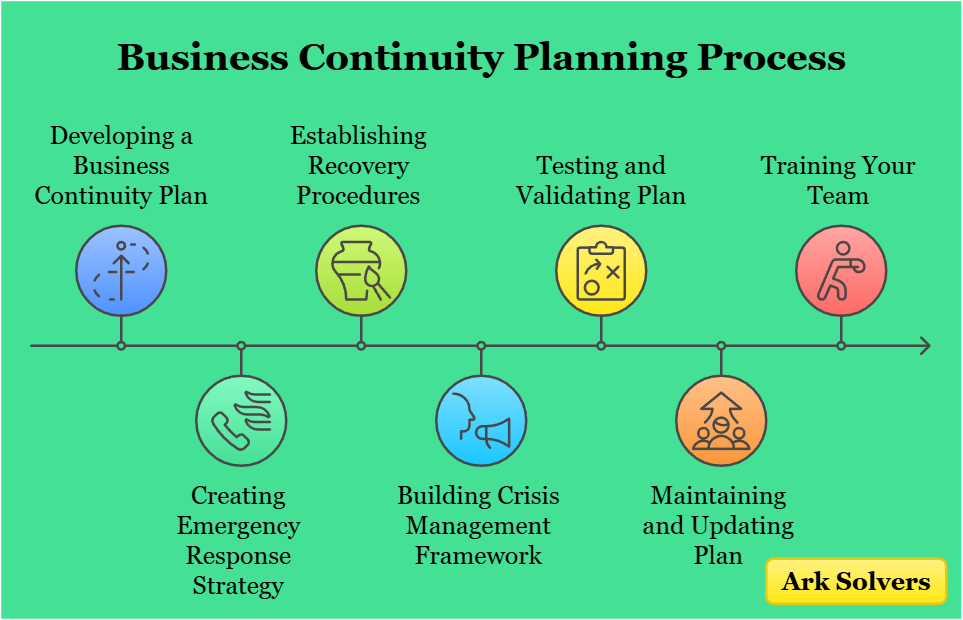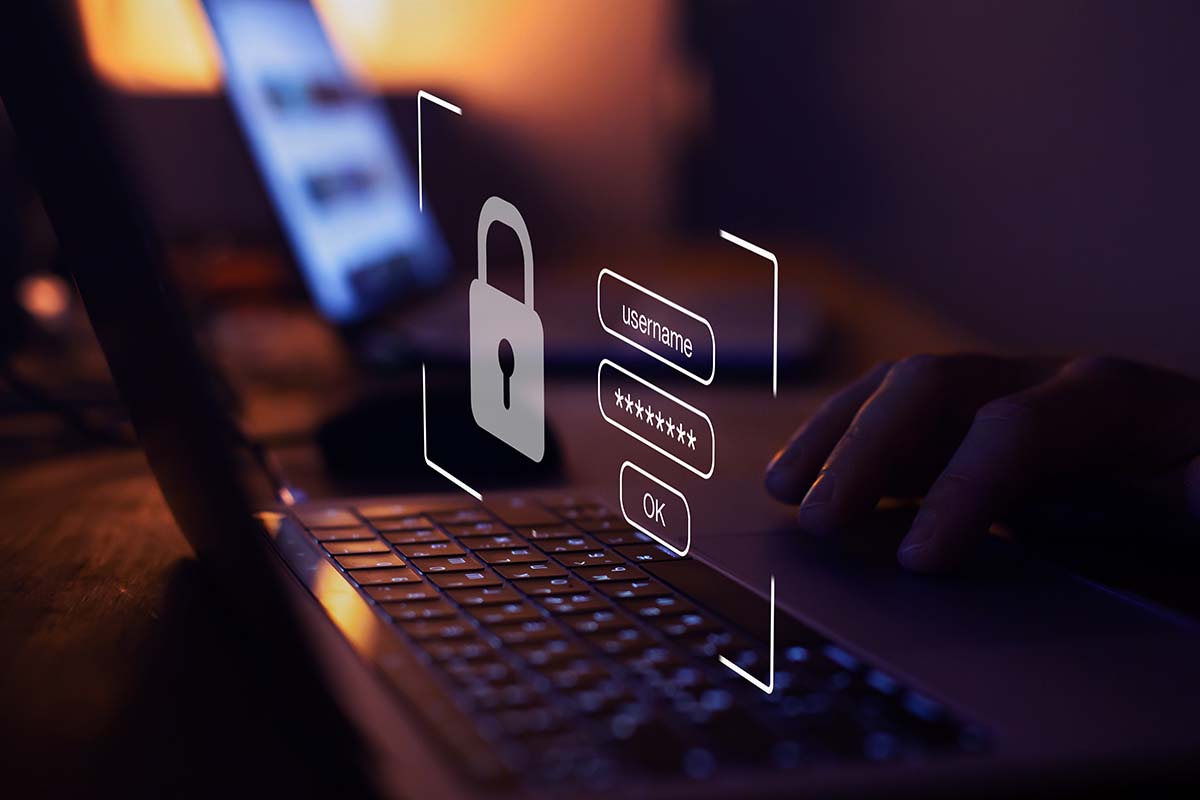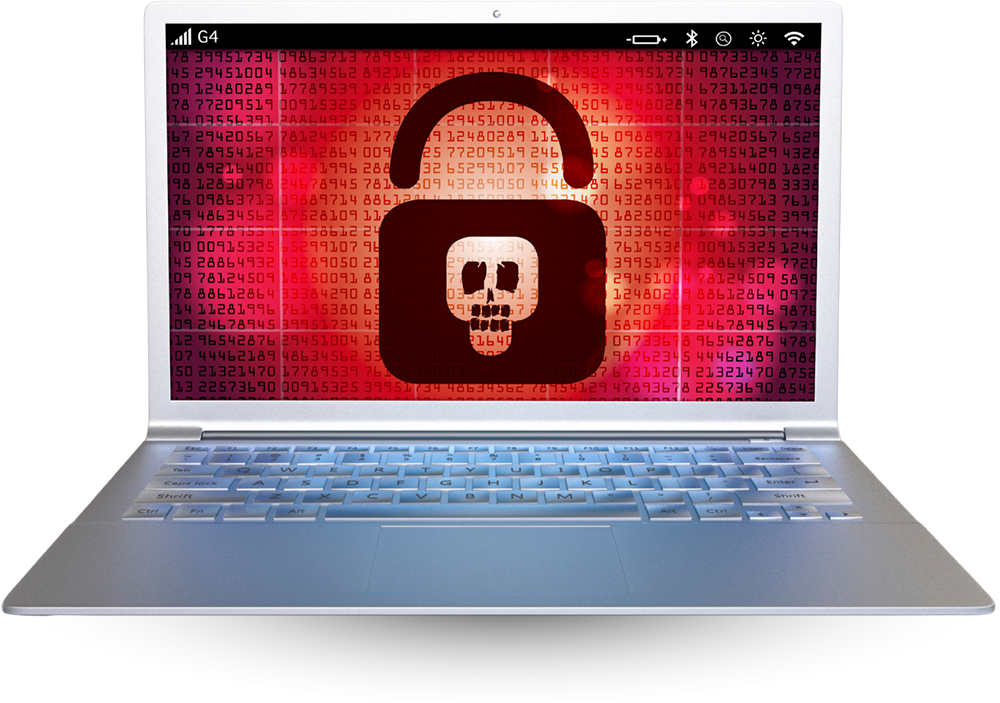Developing a Business Continuity Plan: A Step-by-Step Guide
Imagine if a disaster hit your business, stopping key work and risking everything. Ark Solvers and others worry about this, and they must plan for such times. Planning is key to keeping businesses running after big problems.
It includes making plans for disasters and managing risks. By getting ready for emergencies, businesses can bounce back faster, which makes them stronger in the long run.
Key Takeaways
- Business continuity planning is key for getting ready for big problems.
- A good plan needs a risk management strategy and disaster recovery plan.
- Being ready for emergencies helps lessen the damage.
- Companies like Ark Solvers can make plans that fit their needs.
- Planning keeps businesses running and makes them strong over time.
- With a step-by-step guide, businesses can make a solid plan.

Understanding Business Continuity Planning Fundamentals
Creating a business continuity plan is key for all businesses, big or small. It’s a detailed guide for handling disasters or big problems. It helps keep operations running smoothly even when things go wrong.
Understanding these basics helps businesses make a plan that fits their needs. It is important to mix a business continuity plan with a disaster recovery plan. This way, businesses can handle problems quickly and keep their operations and reputation safe.
What is a Business Continuity Plan?
A business continuity plan is a detailed guide for dealing with disasters or big problems. It’s a big part of keeping a business safe from risks. Making this plan should follow the best practices for business continuity.
Read More: What is Business Continuity? A Complete Guide
Key Components of Effective Continuity Planning
Good continuity planning includes a few main parts:
- Risk assessment: finding out what dangers could face the business
- Business impact analysis: figuring out how big of a hit a problem could be
- Emergency response planning: making plans for how to act in emergencies
Why Every Organization Needs a BCP
Every business needs a plan to stay strong and continue. A good business continuity plan helps reduce the effects of problems, keeps operations going, and protects the business’s image and assets. For the best results, it should work together with a disaster recovery plan.
Assessing Your Organization’s Risk Landscape
It’s key to check your organization’s risk landscape for a business continuity plan. You need to spot possible threats and weak spots and determine how likely and big the disruptions could be.
Consider different risks, such as natural disasters, cyber-attacks, and supply chain problems. These can all affect your business.
Managing risks helps lessen the damage from disruptions. Knowing your risks lets you plan for and handle problems, keeping your business running smoothly.
It is also important to conduct an impact analysis. This shows what could happen if a disruption occurs, helping your business prepare better.
Some important steps for managing business risks include:
- Identifying key business functions
- Figuring out the chances and effects of disruptions
- Creating plans to lessen and deal with disruptions
Being ready for crises is also key to keeping your business going. A good plan helps you act quickly and effectively when problems arise.
Conducting a Business Impact Analysis
When making a business continuity plan, doing a business impact analysis is key. This helps determine what’s most important for your business and examines how disruptions affect your work, money, and reputation.
This analysis helps your business plan how to deal with problems. It ensures your business keeps running smoothly and lessens the effects of disruptions.
A business impact analysis examines what your business needs to keep running. It determines how long you can go without certain things and checks what you need to keep things going, such as people, tools, and technology.
Identifying Critical Business Functions
Finding out what’s most important for your business is a big part of this analysis. It looks at how each part of your business affects your work. It considers how much money it makes, how it affects customers, and if it has to follow rules.
Determining Recovery time Objectives
Figuring out how long you can go without something is also important. This depends on your business plan and what’s most important. It examines how a problem affects your business and what you need to fix.
Analyzing Resource Dependencies
A big part of this analysis is assessing your business needs. It checks what you need to keep things running, like people, tools, and technology. It also looks at whether you have what you need and how to get more if you lose something.
Developing a Business Continuity Plan: Core Steps
Creating a business continuity plan is key for any organization. It must include risk assessment, business impact analysis, and emergency response planning. These steps help make a plan that keeps the business running smoothly, even when things go wrong.
Contingency planning is also vital. It helps spot risks and plan how to deal with them. Having a good disaster recovery strategy is important, too. This includes how to back up and recover data and emergency response plans. These steps help keep the business running without a hitch.
Some important things to think about when making a plan include:
- Regular risk assessments to find threats
- A detailed emergency response plan
- A framework that fits with the organization’s goals
- A disaster recovery plan that keeps data safe and available
By taking these steps and thinking about these points, organizations can make a plan that works for them.
Creating Your Emergency Response Strategy
It’s key to have a good emergency response plan. This helps keep your business running smoothly even when things go wrong. You need a clear plan and the right team to follow it.
A strong emergency response team is vital. It should include people from different areas, such as operations and communications. This team helps put your plan into action.
Emergency Response Team Structure
Your team needs a clear leader and roles for everyone. This ensures everyone knows what to do and helps them act quickly and correctly when emergencies happen.
Communication Protocols
Good communication is key in emergencies. You need a plan for talking to your team, customers, and the public. This plan should tell everyone how to get updates and what to do.
Emergency Response Procedures
Make plans for different emergencies like natural disasters or cyber-attacks. These plans should tell you how to handle the situation and return to normal.
With a solid emergency plan, your team can handle disruptions well, keeping your business running smoothly. It’s all about being ready and knowing what to do.
Establishing Recovery Procedures and Protocols
A business recovery strategy is key to keeping operations running when things go wrong. It’s about setting up steps to get back to normal after disruptions. A process flow chart is important here. It makes the recovery steps clear and shows where things might slow down.
When making recovery plans, think about a few important things. These include:
- Risk assessment: finding out what could go wrong
- Business impact analysis: seeing how disruptions might affect you
- Emergency response planning: making plans for emergencies
Good recovery plans help keep your business running smoothly even when things get tough. They should clearly outline how to get back to normal. A process flow chart helps by showing the main steps and important points in the recovery.
It’s also vital to test and check your recovery plans to ensure their effectiveness. Perform regular drills and update your plans often.
Building Your Crisis Management Framework
Creating a strong crisis management framework is key for any organization. It helps them deal with disruptions and lessen their effects. This framework should cover leadership roles, decision-making, and managing stakeholders. With a clear plan, companies can keep running smoothly and avoid damage to their reputation.
A good crisis management framework lets companies act fast and right when crises hit. It keeps everyone safe, from employees to customers. It’s about spotting risks, figuring out their impact, and finding ways to lessen them. This means setting up clear roles, making quick decisions, and keeping stakeholders happy.
Key Components of a Crisis Management Framework
- Leadership roles and responsibilities: clearly define the roles and responsibilities of team members to ensure effective decision-making and communication.
- Decision-making processes: establishing a clear and efficient decision-making process to respond to crises quickly and effectively.
- Stakeholder management: identifying and managing stakeholders’ expectations, including employees, customers, and the media.
Adding these important parts to a crisis management framework makes a company strong and ready for crises. They do regular risk checks, plan incidents, and set up ways to talk to stakeholders. This keeps everyone informed and helps manage the crisis well.
Testing and Validating Your Continuity Plan
Testing and validation are key to a good business continuity plan. They involve exercises and scenarios that check the plan’s effectiveness and help find ways to improve it.
It’s important to try different exercise types and scenarios. This can be tabletop exercises, simulations, or actual drills. The aim is to see how well the plan works and find what needs fixing. Performance metrics like how fast it responds and communicates are important.
It’s vital to check how well the plan works. This means observing how it handles different situations and identifying what could be improved. It’s also good to test the plan often to keep it working well.
- Identifying possible risks and threats
- Creating scenarios to test the plan
- Looking at the plan’s performance metrics
- Finding areas to improve
By taking these steps and trying different exercise types and scenarios, companies can ensure that their plan is effective. Regular testing and validation help find and fix problems, keeping the plan effective and up-to-date.
Maintaining and Updating Your Business Continuity Plan
Keeping your business continuity plan up to date is key. Regular reviews help spot areas for improvement, allowing you to update your plan to stay ready for risks.
Some important steps for upkeep include:
- Regular risk assessments to find new or changing threats
- Updating emergency response plans
- Making sure everyone knows their part
Focusing on updates keeps your plan strong. This reduces the effect of disruptions and keeps your business running smoothly. Keeping your team informed is also vital for success.
Training Your Team for Business Continuity Success
Effective team training is key to a business continuity plan’s success. It gives employees the knowledge and skills to handle disruptions, allowing organizations to keep their operations running smoothly during emergencies.
Team training includes employee awareness, role-specific training, and drills. Awareness programs teach employees about the importance of business continuity. Role-specific training equips them with the skills needed for their duties during disruptions. Drills make sure employees know how to act quickly and effectively in emergencies.
- Regular training sessions and updates keep employees informed about the business continuity plan.
- Drills and exercises test the plan and help find ways to improve.
- Encouraging employee feedback ensures that the plan works well and is relevant.
Organizations can prepare their employees by following these best practices and providing ongoing training. This readiness helps maintain business operations during disruptions, a big step towards the success of the business continuity plan.
Also Read,
Conclusion: Ensuring Long-Term Business Resilience
Creating a solid business continuity plan is key to lasting success. By following the steps in this guide, companies can lessen the effects of disruptions, helping them keep running smoothly.
Success comes from knowing your risks, understanding how they affect you, and planning for emergencies. These steps help your team face tough times with confidence.
Make these practices a part of your company’s culture. Regularly test and update your plan. Also, keep your team trained and ready for any challenge. With a strong disaster recovery plan, your business can thrive for years.
FAQ
What is a business continuity plan?
A business continuity plan is a detailed document. It outlines how to handle and recover from disasters or disruptions. It helps keep operations going even when things go wrong.
What are the key components of effective continuity planning?
Key parts are risk assessment, business impact analysis, and emergency response planning. These help spot threats, understand disruption effects and develop a recovery plan.
Why does every organization need a business continuity plan?
Every business needs a plan to stay strong and succeed. A good plan reduces the impact of disruption, keeps operations running, and protects reputation and finances.
How do you conduct a business impact analysis?
You start by determining what’s most important in your business. Then, you determine how fast you need to get back to normal. Lastly, you consider what you need to keep things running.
What are the core steps in developing a business continuity plan?
First, conduct a risk assessment. Then, conduct a business impact analysis. Next, create an emergency response plan. Set up recovery steps, build a crisis management team, and test the plan often.
How do you create an effective emergency response strategy?
Start by setting up an emergency team. Then, make plans for communicating and responding. This ensures quick and effective action during disruptions.
How do you establish recovery procedures and protocols?
Outline steps to get back to normal after disruptions. Consider what’s most important and how to keep it running. This includes risk assessment and emergency planning.
What are the key components of a crisis management framework?
Key parts include setting up leadership roles and decision-making processes and managing stakeholders’ expectations. This helps respond quickly and keep operations going.
How do you test and validate a business continuity plan?
Test the plan with exercises and scenarios. This will check whether the plan works and identify areas for improvement. Focus on risk assessment and emergency planning.
How do you maintain and update a business continuity plan?
Review and update the plan regularly to keep it current with your organization’s changes. Focus on risk assessment and emergency planning.
How do you train your team for success in business continuity?
Train employees with awareness programs and role-specific training. Also, have regular drills. This ensures everyone knows their part in responding to disruptions.






